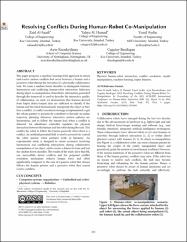Please use this identifier to cite or link to this item:
https://hdl.handle.net/20.500.11779/1996Full metadata record
| DC Field | Value | Language |
|---|---|---|
| dc.contributor.author | Başdoğan, Çağatay | - |
| dc.contributor.author | Küçükyılmaz, Ayşe | - |
| dc.contributor.author | Hamad, Yahya M. | - |
| dc.contributor.author | Aydın, Yusuf | - |
| dc.contributor.author | Al-Saadi, Zaid | - |
| dc.date.accessioned | 2023-10-18T12:13:23Z | |
| dc.date.available | 2023-10-18T12:13:23Z | |
| dc.date.issued | 2023 | - |
| dc.identifier.citation | Al-Saadi, Z., Hamad, Y. M., Aydin, Y., Kucukyilmaz, A., & Basdogan, C. (2023, March). Resolving Conflicts During Human-Robot Co-Manipulation. In Proceedings of the 2023 ACM/IEEE International Conference on Human-Robot Interaction (pp. 243-251). | en_US |
| dc.identifier.isbn | 9781450399647 | - |
| dc.identifier.issn | 2167-2148 | - |
| dc.identifier.uri | https://doi.org/10.1145/3568162.3576969 | - |
| dc.identifier.uri | https://hdl.handle.net/20.500.11779/1996 | - |
| dc.description | UK Research and Innovation, UKRI: EP/S033718/2, EP/T022493/1, EP/V00784X | en_US |
| dc.description | This work is partially funded by UKRI and CHIST-ERA (HEAP: EP/S033718/2; Horizon: EP/T022493/1; TAS Hub: EP/V00784X). | en_US |
| dc.description.abstract | This paper proposes a machine learning (ML) approach to detect and resolve motion conflicts that occur between a human and a proactive robot during the execution of a physically collaborative task. We train a random forest classifier to distinguish between harmonious and conflicting human-robot interaction behaviors during object co-manipulation. Kinesthetic information generated through the teamwork is used to describe the interactive quality of collaboration. As such, we demonstrate that features derived from haptic (force/torque) data are sufficient to classify if the human and the robot harmoniously manipulate the object or they face a conflict. A conflict resolution strategy is implemented to get the robotic partner to proactively contribute to the task via online trajectory planning whenever interactive motion patterns are harmonious, and to follow the human lead when a conflict is detected. An admittance controller regulates the physical interaction between the human and the robot during the task. This enables the robot to follow the human passively when there is a conflict. An artificial potential field is used to proactively control the robot motion when partners work in harmony. An experimental study is designed to create scenarios involving harmonious and conflicting interactions during collaborative manipulation of an object, and to create a dataset to train and test the random forest classifier. The results of the study show that ML can successfully detect conflicts and the proposed conflict resolution mechanism reduces human force and effort significantly compared to the case of a passive robot that always follows the human partner and a proactive robot that cannot resolve conflicts. © 2023 Copyright is held by the owner/author(s). | en_US |
| dc.language.iso | en | en_US |
| dc.publisher | IEEE Computer Society | en_US |
| dc.rights | info:eu-repo/semantics/openAccess | en_US |
| dc.subject | Machine-learning | en_US |
| dc.subject | Conflict resolution | en_US |
| dc.subject | Statistical tests | en_US |
| dc.subject | Classification (of information) | en_US |
| dc.subject | Machine learning approaches | en_US |
| dc.subject | Haptics | en_US |
| dc.subject | Dyadic manipulation | en_US |
| dc.subject | Dyadic manipulation | en_US |
| dc.subject | Human robots | en_US |
| dc.subject | Man machine systems | en_US |
| dc.subject | Machine learning | en_US |
| dc.subject | Conflict resolution | en_US |
| dc.subject | Robot programming | en_US |
| dc.subject | Physical humanrobot interaction (phri) | en_US |
| dc.subject | Haptic feature | en_US |
| dc.subject | Machine learning | en_US |
| dc.subject | Human robot interaction | en_US |
| dc.subject | Random forest classifier | en_US |
| dc.subject | Physical human-robot interaction | en_US |
| dc.subject | Collaborative tasks | en_US |
| dc.subject | Haptic features | en_US |
| dc.title | Resolving Conflicts During Human-Robot Co-Manipulation | en_US |
| dc.type | Conference Object | en_US |
| dc.identifier.doi | 10.1145/3568162.3576969 | - |
| dc.identifier.scopus | 2-s2.0-85150378758 | - |
| dc.identifier.wosquality | N/A | - |
| dc.identifier.scopusquality | N/A | - |
| dc.relation.publicationcategory | Konferans Öğesi - Uluslararası - Kurum Öğretim Elemanı | en_US |
| dc.identifier.endpage | 251 | en_US |
| dc.identifier.startpage | 243 | en_US |
| dc.department | Mühendislik Fakültesi, Elektrik Elektronik Mühendisligi Bölümü | en_US |
| dc.relation.journal | 18th Annual ACM/IEEE International Conference on Human-Robot Interaction, HRI 2023 -- 13 March 2023 through 16 March 2023 -- 187136 | en_US |
| dc.relation.journal | ACM/IEEE International Conference on Human-Robot Interaction | en_US |
| dc.institutionauthor | Aydın, Yusuf | - |
| item.openairecristype | http://purl.org/coar/resource_type/c_18cf | - |
| item.openairetype | Conference Object | - |
| item.languageiso639-1 | en | - |
| item.cerifentitytype | Publications | - |
| item.fulltext | With Fulltext | - |
| item.grantfulltext | open | - |
| crisitem.author.dept | 02.05. Department of Electrical and Electronics Engineering | - |
| Appears in Collections: | Elektrik Elektronik Mühendisliği Bölümü Koleksiyonu Scopus İndeksli Yayınlar Koleksiyonu / Scopus Indexed Publications Collection | |
Files in This Item:
| File | Description | Size | Format | |
|---|---|---|---|---|
| 3568162.3576969.pdf | Full Text- Article | 3.74 MB | Adobe PDF |  View/Open |
CORE Recommender
SCOPUSTM
Citations
9
checked on Mar 29, 2025
Page view(s)
108
checked on Mar 31, 2025
Download(s)
42
checked on Mar 31, 2025
Google ScholarTM
Check
Altmetric
Items in GCRIS Repository are protected by copyright, with all rights reserved, unless otherwise indicated.